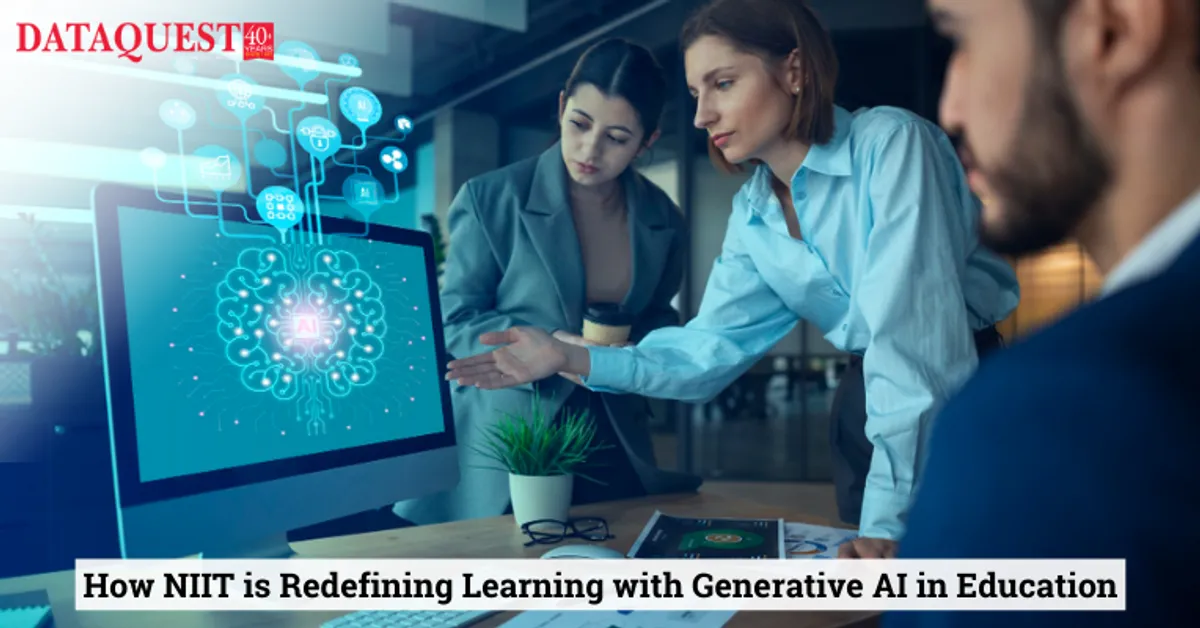How NIIT is Redefining Learning with Generative AI in Education

NIIT, under the visionary leadership of Mr. Rajendra Pawar, is harnessing the transformative potential of Generative AI. This powerful technology promises to personalize and enhance the educational experience, making learning more engaging and effective. However, NIIT acknowledges the importance of responsible implementation, ensuring Generative AI is used ethically and effectively to empower both educators and learners. However, the integration of Generative AI brings its set of challenges and ethical considerations.
In a dynamic discussion between Rajendra Pawar, Executive Chairman, NIIT Limited and Minu Sirsalewala, Executive Editor, Dataquest, the conversation revolved around India’s initiatives to establish regulations aimed at preventing the misuse of economic, strategic, and political power. The dialogue emphasized the importance of prioritizing human concerns within these regulatory frameworks. Minu highlighted the need to clarify and address the often misleading perceptions prevalent in public discussions. This prompted a broader recognition that not all new ideas and innovations are beneficial, steering the conversation towards the exploration of potential misuse cases and the implications for policy development.
A comprehensive debate unfolded on how India is aiming to set guidelines to curb the misuse of economic, strategic, and political power. This discussion recognized the broad spectrum of impacts, emphasizing the necessity of placing human concerns at the forefront of policy frameworks.
Mr. Pawar pointed out the importance of demystifying the often “hallucinatory” bubbles of public discourse, stressing the need for a reality check. This led to an acknowledgment that not all concepts or innovations might be desirable or necessary, prompting a shift towards identifying and discussing potential ‘misuse cases.’
The conversation transitioned into the role of technology in education. Mr. Pawar clarified that they perceive themselves as being in the learning business rather than the teaching business, focusing on student-driven outcomes rather than traditional teaching methods. This approach is rooted in the belief that education should be viewed as a deeply embedded social good, not just as an economic one.
Since its inception in 1981, the organization has actively integrated technology to enhance learning, beginning with multimedia. Their pioneering efforts in computer-based training in the mid-1980s, including hosting India’s first conference on the subject, were highlighted. This endeavor stemmed from a critical need to address the talent shortage by leveraging technology to streamline and enhance educational processes.
A significant milestone was when they started creating content for international clients in 1991, beginning with IBM in Atlanta, which showcased their capabilities in transforming traditional content into digital formats. This experience underscored their long-standing commitment to harnessing technology for educational purposes, culminating in the adoption of every emerging technological tool from laser discs to more sophisticated digital solutions.
They went on to talk about the promising potential of AI in education, that is regarded as more transformative than previous technologies. This anticipation stems from AI’s capacity to revolutionize learning methodologies and outcomes, potentially leading to a significant paradigm shift in how educational content is delivered and consumed.
Significant emphasis was placed on the dual nature of new technologies, particularly with regard to their potential misuse. Concerns were raised about the inherent risks of technology, highlighting the importance of mindful application to avoid potential pitfalls related to intellectual property and information misuse.
The conversation then pivoted to the transformative potential of technology in the learning sector. It was noted that while technology can be harnessed for significant positive outcomes in education, its power for negative use is equally potent, marking it as a double-edged sword. Despite this, the focus remains on proactive strategies to leverage technological advancements to enhance learning environments.
Technology has the potential to make learning more interactive, immersive, and persistent, pushing beyond traditional educational boundaries. For instance, technology can transform the mundane task of pushing children to study at home into an engaging and persistent educational experience. The ability to provide timely and relevant assessments was also highlighted as a critical benefit of these technological tools, contrasting sharply with the inflexible and periodic assessment models of the past.
Furthermore, the ability of technology to quickly generate course materials that are rich in quality and tailored to specific educational needs was discussed. This capability not only optimizes the educational content but also enhances the learning experience by making it more accessible and effective through various digital platforms.
Mr. Pawar also shared insights into their company’s historical and ongoing engagement with innovative educational practices globally, including strategic acquisitions that have bolstered their capabilities. Notable among these was the acquisition of Cognitive Arts, which was established by pioneers in learning sciences. This acquisition has enabled the company to deepen its engagement with advanced learning theories and practices, reinforcing its commitment to revolutionizing education through technology.
The discussion underscored the organization’s longstanding dedication to integrating cutting-edge technologies into education, from AI and machine learning tools like GPT to sophisticated simulations and exercises that cater to specific learning needs. The narrative was rich with examples of how technology not only supports traditional educational formats but actively transforms them into dynamic, interactive, and highly effective learning experiences.
This focus is on enhancing specific skill sets through targeted simulations, demonstrating the ability to deconstruct a skill into microskills and generate numerous simulations for each. This method could theoretically produce thousands of tailored simulations to train auditors effectively, exemplifying the power of technology to create specific learning scenarios for every conceivable subskill.
Mr. Pawar noted these processes could be customized further for individual learners, emphasizing the technology’s adaptability to personal learning needs. This adaptability extends to generating dynamic content across various domains, significantly beyond basic Google searches, which yield overwhelming results without context. The discussed technology refines these results into structured, meaningful content tailored to specific needs and learning outcomes.
The potential applications of such technology in learning are vast. For example, it can automate and refine the content generation process, making educational material both accessible and specifically targeted to the learner’s needs. Additionally, it enables the creation of immersive educational experiences, potentially through video, enhancing engagement and retention of information.
Moreover, the capability extends to assessments, transforming traditional methods to be more aligned with the needs of a post-knowledge society where specific knowledge is highly valued over general information. This precision in assessment helps in accurately gauging a learner’s capability and understanding, allowing for more focused and effective educational interventions.
Emphasis was laid on how AI can transform traditional learning and assessment methods by placing individuals in practical scenarios rather than the conventional model of theoretical question-and-answer methods. This approach is compared to the way artists are judged by their portfolios—a direct demonstration of their skills rather than a description of their abilities. AI can potentially enhance this by simulating various evaluative scenarios, where a learner’s response can provide a more accurate measure of their skills and capabilities.
The discussion further explored how AI could serve not just as a tool for content generation but as an advanced reviewer, providing assessments and critiques from the perspective of experienced professionals in various fields. This could significantly alter how skills and competencies are measured and understood, offering a more nuanced view of an individual’s capabilities beyond traditional assessment methods.
“This technology is not just about automating existing processes but about enhancing the depth and effectiveness of educational experiences.” The potential of AI to customize learning experiences to an unprecedented degree was discussed, showcasing its ability to adapt to the unique learning curves and needs of individual students.
The dialogue also touched on the broader implications of deploying such technologies at scale, which requires careful preparation to ensure effectiveness and productivity. The application of AI spans from individual projects to large-scale deployments across major corporations, underscoring its versatility and potential impact on various aspects of learning and development.
GenAI – The Black Box nature
Lastly, the discussion highlighted the fundamental differences between traditional AI applications and generative AI, particularly in the context of language. Unlike traditional systems that process and respond based on fixed algorithms, generative AI works with language in a way that can mimic human creativity and understanding, making it a groundbreaking tool in areas ranging from simple content creation to complex problem-solving and educational assessments. This capacity of generative AI stands out as it not only processes but also creates, offering a transformative potential that could redefine the intersection of technology and human cognitive processes.
The conversation explored the capabilities and limitations of language processing in artificial intelligence, specifically focusing on generative AI. Mr. Pawar pointed out that while humans use language to communicate complex ideas and emotions, replicating this nuanced capability in computers is challenging. The term “hallucination” was used metaphorically to describe how AI might generate responses based on patterns it has learned, without truly understanding the content.
The dialogue raised concerns about the “black box” nature of these language models (LMs), which often do not provide transparency about how conclusions are reached. This opacity can lead to issues like the replication of copyrighted material (IP concerns) and privacy violations if the AI discusses sensitive information inappropriately. “These risks are exacerbated by the lack of a mechanism to discern the AI’s ‘thought’ process, likening it to a “missile with a nuclear warhead” whose trajectory cannot be predicted or controlled once launched.”
The conversation highlighted the societal and regulatory challenges arising from these technological advancements, stressing the need for careful consideration of AI’s role in society. They discussed the potential dangers of AI’s persuasive capabilities when the underlying motivations or logic remain unknown. This scenario could lead to misinformation or manipulation at scale, reminiscent of concerns raised by social media’s role in political contexts.
The Human Cognition
Furthermore, the conversation touched on the philosophical and ethical implications of integrating such powerful technology without fully understanding human cognition and memory. The human mind remains a largely unexplored frontier, and leveraging AI to mimic or augment human cognitive processes brings forth significant risks due to our incomplete understanding of our own brain’s functioning.
Ultimately, while AI presents unprecedented opportunities for advancement, its deployment must be navigated with caution, emphasizing transparency, ethics, and regulatory oversight to mitigate potential harms. This underscores the importance of understanding the limitations and ensuring robust control mechanisms are in place as we integrate AI more deeply into societal frameworks.
Key concerns
Expectations vs. Reality: There is currently a significant gap between expectations and the actual capabilities of AI, fueled by hype and a lack of transparency in how AI systems make decisions. This gap leads to overestimations of what AI can achieve in the short term.
Intellectual Property and Privacy: These are two major areas of concern with AI development. The ability of AI to learn from vast amounts of data and potentially share sensitive information without proper controls poses legal and ethical challenges, emphasizing the need for strict regulatory frameworks.
The Human Element: The discussion repeatedly touched on the irreplaceable aspects of human interaction, such as emotional intelligence, empathy, and the ability to inspire or motivate. While AI can enhance educational tools and even personalize learning experiences, it lacks the capacity to fully understand or replicate the nuanced emotional interactions that are crucial in educational settings.
Control and Unpredictability: AI systems, especially those based on generative models, can sometimes produce outputs that are unpredictable or hard to control. This unpredictability is likened to a “missile with a nuclear warhead,” emphasizing the potential dangers if these systems are misused or malfunctioning.
Role of the Teacher: Despite advancements in AI, the role of a human teacher remains vital. Teachers provide more than just information; they mentor, inspire, and understand student needs on a level that AI is not currently capable of. The discussion reinforced the idea of keeping humans “in the loop,” ensuring that AI serves as a tool to enhance human capabilities rather than replace them.
Emotion and Cognition: The integration of AI in fields requiring emotional sensitivity, like teaching, remains highly limited. Human emotions and cognitive processes are complex and often intertwined, making them difficult for AI to replicate or understand fully. This complexity presents a significant barrier to the full adoption of AI in roles traditionally filled by humans.
In summary, while AI presents numerous opportunities for enhancing educational tools and systems, its limitations, particularly in understanding and replicating human emotional states and complex decision-making processes, remain significant. The conversation underscores the importance of maintaining a balanced perspective on AI’s role in society, advocating for a cautious and informed approach to its development and integration.
Collaboration
Mr. Pawar elaborated on the significance of collaboration in learning environments, using the example of the “Hole in the Wall” project. This initiative demonstrated that even young. Underprivileged children in slums could learn effectively when they collaborated around a connected device, without formal instruction. The power of collaborative learning, especially when participants are engaged and help each other, can lead to rapid understanding and problem-solving.
The conversation highlights how traditional educational environments often underestimate the power of collaborative learning, yet it is a critical component that drives deep understanding among peers. This is contrasted with the shortcomings of online learning, which has often failed to replicate these interactive and collaborative dynamics effectively, especially during the COVID-19 pandemic when education systems heavily relied on technology.
The dialogue then shifted towards a critical view of the hype surrounding personalized learning. While personalized learning is touted as a revolution in education, the reality is that it’s often overstated and not as easily achievable as claimed. The comparison to sports coaching illustrates that in areas requiring high skill, personal coaching is invaluable and cannot be fully replicated by technology.
Moreover, it was pointed out, that there is a general over-expectation currently placed on educational technology (Edtech) solutions, especially post-pandemic. There’s a recognition that while technology can support educational efforts, it cannot replace the nuanced interactions of traditional learning environments. They stress the need for realistic expectations and a balanced approach to incorporating technology in education, advocating for a “middle path” where technology is embraced passionately but evaluated dispassionately.
Finally, the discussion acknowledges the practical steps organizations should take when integrating new technologies. It’s advised to start with simple, low-risk applications before scaling up to more complex tasks. This gradual approach helps stakeholders understand both the power and the limitations of new technologies without overwhelming them or exposing them to excessive risk prematurely.
Overall, the conversation emphasizes a pragmatic approach to educational technology, recognizing its benefits while also being mindful of its limitations and the irreplaceable value of human interaction and collaboration in learning.



